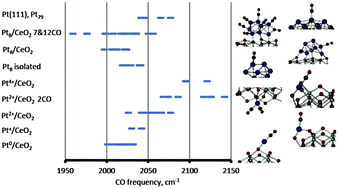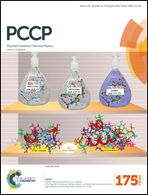Can the state of platinum species be unambiguously determined by the stretching frequency of an adsorbed CO probe molecule?†
Abstract
The paper addresses possible ambiguities in the determination of the state of platinum species by the stretching frequency of a CO probe, which is a common technique for characterization of platinum-containing catalytic systems. We present a comprehensive comparison of the available experimental data with our theoretical modeling (density functional) results of pertinent systems – platinum surfaces, nanoparticles and clusters as well as reduced or oxidized platinum moieties on a ceria support. Our results for CO adsorbed on-top on metallic Pt0, with C–O vibrational frequencies in the region 2018–2077 cm−1, suggest that a decrease of the coordination number of the platinum atom, to which CO is bound, by one lowers the CO frequency by about 7 cm−1. This trend corroborates the Kappers–van der Maas correlation derived from the analysis of the experimental stretching frequency of CO adsorbed on platinum-containing samples on different supports. We also analyzed the effect of the charge of platinum species on the CO frequency. Based on the calculated vibrational frequencies of CO in various model systems, we concluded that the actual state of the platinum species may be mistaken based only on the measured value of the C–O vibrational frequency due to overlapping regions of frequencies corresponding to different types of species. In order to identify the actual state of platinum species one has to combine this powerful technique with other approaches.



 Please wait while we load your content...
Please wait while we load your content...